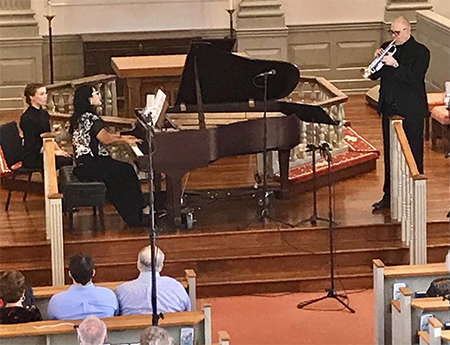by Peter Feher

Not that Sunday’s concert didn’t have its orchestral moments. Sutte reserved an expansive but hard-edged tone — the kind of sound that cuts through an ensemble — for musical high points and the ends of movements. A couple of mutes, sparingly used, lent symphonic color to the music. And pianist Christine Fuoco was her own orchestra of one, more than a match for Sutte’s biggest, brassiest playing.
But most often, Sutte favored a soft, expressive sound, not distinctly trumpety and geared towards a smaller space. In fact, outside of the chamber repertoire, you’d most likely hear this sort of thing in a jazz setting, though Sutte brought all the virtues of classical legato playing to the intimate setup. Long notes were something to look forward to, carefully shaped and with a substantial but subtle vibrato.
Sunday’s program played to these lyrical strengths. Sutte and Fuoco took on three 20th-century sonatas — mostly tonal, a little bit modern — from a period that saw composers extending serious solo treatment to the trumpet. This was a productive time for the genre, though with dark undertones, reflected in the program’s title, “Sonatas from World War II.”
Karl Pilss’ Trumpet Sonata is part innovative, part reactionary. Written in 1935, it adapts the large-scale harmonies of Mahler and Richard Strauss — already out of fashion at the time — to its chamber music proportions. Sutte and Fuoco brought a sense of gravity to their performance, especially in the piece’s spacious final measures.
Paul Hindemith wrote a sonata for almost every wind instrument, and many of them are rightly cornerstones of their repertoire. His Trumpet Sonata makes full use of the instrument in long chorale melodies, short bugle-like bursts, and even accompanimental figures that aren’t typical for an instrument that’s often the star of the show. And Hindemith had a knack for endings both satisfying and disarming. Sutte and Fuoco arrived at the work’s final cadence, part of a setting of Bach’s “Alle Menschen müssen sterben,” with appropriate eeriness.
Jean Hubeau’s Sonata injected a little humor among mostly solemn music. In its short second movement, “Intermède,” the trumpet flutter-tongues and parodies itself with burlesque fanfare passages. It was also a chance for the trumpet to taste a little of the note-heavy action that the piano supplied throughout the program.
A special moment in the final movement, “Spiritual,” featured Sutte playing with both a mute and a cloth covering the mute. The result was a forlorn melody, drawn out almost as if played on English horn — a reminder that the orchestral world is never far away.
Published on ClevelandClassical.com March 17, 2020.
Click here for a printable copy of this article



